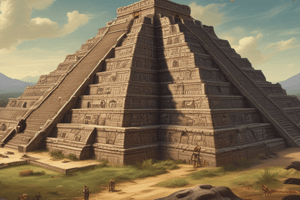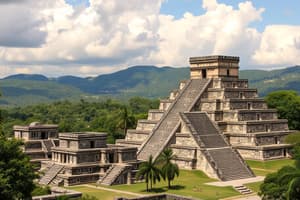Podcast
Questions and Answers
What was the capital city of the Aztec Civilization?
What was the capital city of the Aztec Civilization?
- Tenochtitlan (correct)
- Mexico City
- Chichen Itza
- Teotihuacan
What type of education did the common boys, or 'Macehualtin', receive in Aztec society?
What type of education did the common boys, or 'Macehualtin', receive in Aztec society?
- Training in agriculture and aquaculture
- Ancient history and philosophy
- Military training and leadership skills
- Warfare and their way of living (correct)
Which of the following was a primary use of Chinampa in Aztec civilization?
Which of the following was a primary use of Chinampa in Aztec civilization?
- Ceremonial rituals
- Transportation of goods
- Agriculture and Aquaculture (correct)
- Construction of temples
How many human sacrifices did the Aztecs reportedly perform each year?
How many human sacrifices did the Aztecs reportedly perform each year?
What was the unique feature of the Aztec calendar?
What was the unique feature of the Aztec calendar?
Which flower was known for its medicinal properties in the Aztec culture?
Which flower was known for its medicinal properties in the Aztec culture?
What material did the Aztecs primarily use to make their canoes?
What material did the Aztecs primarily use to make their canoes?
What was a significant ecological benefit of Chinampas?
What was a significant ecological benefit of Chinampas?
What was one of the main reasons for the value placed on education in the Aztec civilization?
What was one of the main reasons for the value placed on education in the Aztec civilization?
Which of the following statements accurately describes the Aztec calendar system?
Which of the following statements accurately describes the Aztec calendar system?
Which method did the Aztecs use for the construction of their canoes?
Which method did the Aztecs use for the construction of their canoes?
What role did chinampas play in the Aztec society?
What role did chinampas play in the Aztec society?
What is a significant aspect of Aztec religion?
What is a significant aspect of Aztec religion?
Which group of children attended the Calmecac schools in Aztec society?
Which group of children attended the Calmecac schools in Aztec society?
What medical advancement were the Aztecs recognized for?
What medical advancement were the Aztecs recognized for?
What ecological advantage did chinampas provide to the Aztec civilization?
What ecological advantage did chinampas provide to the Aztec civilization?
Flashcards are hidden until you start studying
Study Notes
Aztec Civilization Overview
- Flourished in Central Mexico from 1325 to 1521 during the post-classic period.
- Originated in Central America around the 13th century.
- Capital city was Tenochtitlan, now modern-day Mexico City.
Key Archaeological Site
- Teotihuacan Pyramid is a significant ancient site and one of the world’s foremost archaeological treasures.
Religion and Practices
- Polytheistic belief system with significant emphasis on human sacrifice.
- Estimated 20,000 human sacrifices per year, involving ritualistic methods such as heart extraction and body disposal from pyramids.
- Some accounts suggest royalty consumed the bodies of the sacrificed.
Education System
- Education was mandatory; all children attended schools to learn traditions and history.
- Common people were termed "Macehualtin"; boys trained at Telpochcalli for warfare and lifestyle skills.
- Noble children, known as "Calmecac," received training for roles in military, priesthood, and government.
- Girls attended separate schools focusing on essential knowledge for women.
Medical Innovations
- The Aztecs advanced in medicine, developing antispasmodic medications to alleviate muscle spasms.
- Utilized Passion Flower among other plants for medicinal purposes.
Agricultural Techniques
- Chinampa, known as "floating gardens," were artificially created in lakes and wetlands in the Valley of Mexico.
- Served multiple purposes: agriculture, aquaculture, and housing.
- Provided a stable food supply, essential for the large population, while also improving water quality and preventing erosion.
Inventions and Tools
- Canoes made from hollowed-out logs of Ahuehuete (Mexican cypress) for transport, fishing, hunting, and warfare.
- Crafted using obsidian and flint tools for shaping wood.
Calendar System
- Aztec calendar featured two main cycles: the 260-day Tonalpohualli (religious) and the 365-day Xiuhpohualli (solar).
- Alignment of the two cycles occurred every 52 years, celebrated with ceremonies ensuring the world's survival.
- A prominent stone calendar depicting the Sun God Tonatiuh was discovered in 1790, now housed in Mexico City’s National Museum.
Aztec Civilization Overview
- Flourished in Central Mexico from 1325 to 1521 during the post-classic period.
- Originated in Central America around the 13th century.
- Capital city was Tenochtitlan, now modern-day Mexico City.
Key Archaeological Site
- Teotihuacan Pyramid is a significant ancient site and one of the world’s foremost archaeological treasures.
Religion and Practices
- Polytheistic belief system with significant emphasis on human sacrifice.
- Estimated 20,000 human sacrifices per year, involving ritualistic methods such as heart extraction and body disposal from pyramids.
- Some accounts suggest royalty consumed the bodies of the sacrificed.
Education System
- Education was mandatory; all children attended schools to learn traditions and history.
- Common people were termed "Macehualtin"; boys trained at Telpochcalli for warfare and lifestyle skills.
- Noble children, known as "Calmecac," received training for roles in military, priesthood, and government.
- Girls attended separate schools focusing on essential knowledge for women.
Medical Innovations
- The Aztecs advanced in medicine, developing antispasmodic medications to alleviate muscle spasms.
- Utilized Passion Flower among other plants for medicinal purposes.
Agricultural Techniques
- Chinampa, known as "floating gardens," were artificially created in lakes and wetlands in the Valley of Mexico.
- Served multiple purposes: agriculture, aquaculture, and housing.
- Provided a stable food supply, essential for the large population, while also improving water quality and preventing erosion.
Inventions and Tools
- Canoes made from hollowed-out logs of Ahuehuete (Mexican cypress) for transport, fishing, hunting, and warfare.
- Crafted using obsidian and flint tools for shaping wood.
Calendar System
- Aztec calendar featured two main cycles: the 260-day Tonalpohualli (religious) and the 365-day Xiuhpohualli (solar).
- Alignment of the two cycles occurred every 52 years, celebrated with ceremonies ensuring the world's survival.
- A prominent stone calendar depicting the Sun God Tonatiuh was discovered in 1790, now housed in Mexico City’s National Museum.
Studying That Suits You
Use AI to generate personalized quizzes and flashcards to suit your learning preferences.




